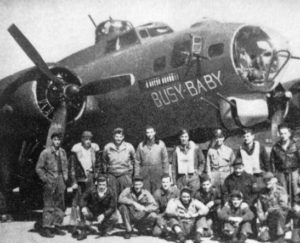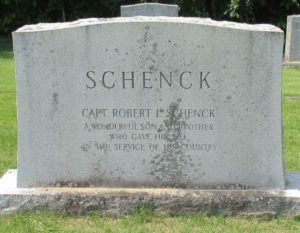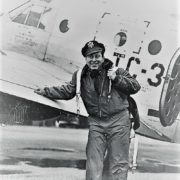Family Service and Sacrifice
By Marc Schenck
In the course of researching our family tree with my father, Lt. j.g. Bernard Schenck, a Navy veteran who served during the Cold War between 1956-1960 on the USS Virgo (KA-20) and the USS Glacier (AGB-4), I first learned about the scope of one of our family member’s military service in two wars. Forgotten by most, his sacrifice is worthy of acknowledgment and our memory.
My father’s uncle, Mack Schenck, was an immigrant from Belarus along with his four siblings, probably in the first decade of the century. In 1928, along with three other men, they founded Temple Beth-El Congregation in Great Neck, New York. At the time, Great Neck had a population of 12,000 people and only 115 Jewish families. It was the first synagogue in the town.

The Busy Baby, circa 1944, United Kingdom
Mack had a son named Robert Schenck, my father’s cousin, born on May 30, 1921. He was a bomber pilot who flew a B-17 Flying Fortress in World War II and received the Distinguished Flying Cross. As part of the 379th Bomb Group, 527th Bomb Squadron, based at Kimbolton, UK, they flew more sorties than any other Bomb Group in the Eighth Air Force and dropped a greater bomb tonnage than any other Group.
The B-17 Flying Fortress Group was awarded two Distinguished Unit Citations, the first for operations between May 28, 1943 and July 31, 1944. Its first combat mission was the bombing of German U-boat pens at St Nazaire, France, on May 29, 1943. The second was awarded to the 1st Bomb Division as a whole for flying without fighter protection to bomb aircraft factories at Oschersleben, Germany, on January 11, 1944.
Flying with the 527th during the Spring and Summer of 1944 Capt. Robert Schenck participated in missions throughout Western Europe and as far east as Poland. Several missions over Germany flew into the highly defended airspace above Berlin. It was a hazardous profession for the aircrews and more American airmen died over Europe than Marines died in the Pacific. He flew 35 missions, mostly on the Busy Baby, above the minimum of 25, and later 30, necessary for having the option to return home. By November 1944, the Busy Baby, after 87 missions, was classified as war weary. It was relegated to scrap in Kingman, Arizona in December of 1945.

Schenck’s headstone in Beth-Alom Cemetery in New Britain, CT.
After the war, his path was less clear, but a family member recalls hearing that he had gone into business importing goods from the Dominican Republic. He remained a reservist and was called back for the Korean War, this time as the senior pilot of a C-119C Flying Boxcar from the 63rd Troop Carrier Squadron, 403rd Troop Carrier Group.
Until the end of 1952, it dropped paratroopers and supplies, transported personnel and equipment, and evacuated casualties in support of the Far East Command and UN forces. The group flew more than 6,300 flights, dropped nearly 10,000 personnel, more than 18,000 tons of cargo, 380 tons of supplies, and airlifted almost 14,000 medical patients.
On November 14, 1952, his aircraft was enroute from Ashiya Air Base, Japan to Seoul, Korea when it crashed into Hill 683 near Cho-ok, about 15 miles east of Airfield K-19, killing all 44 servicemen on board. Robert Schenck was just 31-years-old and was awarded the Korean Service Medal, the United Nations Service Medal, the National Defense Service Medal and the Republic of Korea War Service Medal.
His remains were recovered, and he is interred at Beth-Alom Cemetery in New Britain, Connecticut. He was survived by his parents and siblings. Upon learning of our family history, we will never forget the sacrifice he paid in service of our nation. Remembering is the least we can do.
If any readers have any comments or additional information regarding Capt. Robert Schenck or related events I would welcome them. I can be reached at mschenc1@optonline.net.
Volume 77. Number 1. 2023




